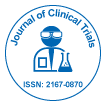
Journal of Clinical Trials
Open Access
ISSN: 2167-0870

ISSN: 2167-0870
Editorial - (2012) Volume 2, Issue 4
Keywords: Homelessness, Mental health, Occupational therapy
Sugammadex, a γ-cyclodextrin that encapsulates selectively steroidal neuromuscular blocking agents, such as rocuronium or vecuronium, has changed the face of clinical neuromuscular pharmacology. Sugammadex allows a rapid reversal of muscle paralysis. After its injection, a train-of-four ratio >0.9 is obtained in less than 5 minutes in all patients, whatever the degree of muscle paralysis and even when anesthesia is maintained with halogenated agents. Sugammadex in blood-brain barrier penetration is poor (<3% in rats). However the blood brain barrier permeability can be altered under different conditions (i.e. neurodegenerative diseases, trauma, ischemia, infections, or immature nervous system). We show here that clinically relevant sugammadex concentrations cause apoptotic neuron death in primary cultures.
A Cochrane systematic review including 18 randomized controlled trials (with a total of 1321 patients) on the efficacy and Safety of Sugammadex (SUG) concluded that it was more effective than placebo (no medication) or neostigmine in reversing muscle relaxation caused by Neuromuscular Blockade (NMB) during surgery and is relatively safe. Serious complications occurred in less than 1% of the patients who received SUG [1]. Reported side effects for SUG included cough, dry mouth, temperature changes, parasomia, paresthesia, movement during surgery, mild erythemia, abdominal discomfort, tachycardia, bradycardia, dizziness, increased creatinine phosphokinase, and increased B2 microglobinuria [2]. Pooled preclinical safety data obtained from the US FDA briefing document [3]; and the European Medicines Agency scientific document [4] reveal no special hazard for humans based on conventional studies of safety pharmacology, repeated dose toxicity, genotoxicity and toxicity to reproduction, local tolerance or compatibility with blood. Potential kidney and lung toxicity of cyclodextrins, if large repeated doses are administered, must be also taken into account [5]. Besides, available information regarding SUG on special conditions/population, including renal impairment, elderly patients, obese patients, and pediatric population is really limited [3,4,6].
SUG exhibits a very low transfer across the Blood-Brain Barrier (BBB) and the placenta. Nevertheless, different clinical conditions imply moderate or severe alterations of the BBB integrity, i.e. Alzheimer [7], Parkinson [8] or multiple sclerosis [9] disease-associated neurodegeneration, traumatic brain/spinal cord injury [10], ischemia [11], meningitis [12], or immature nervous system [13]. Under these clinical conditions, SUG may cross the BBB in specific areas. SUG can act such as potential induced neuronal toxicity.
SUG causes cell death, predominantly by apoptosis, in cultured neurons [14,15]. Apoptosis induction associates with an alteration in neuronal cholesterol homeostasis [15]. In fact, neuronal death caused by inhibition of intracellular cholesterol trafficking has been shown to be caspase dependent and associated with activation of the mitochondrial apoptosis pathway [16]. Cholesterol is an abundant component of plasma membranes of eukaryotic cells and is an essential regulator of membrane fluidity, permeability, receptor function, and ion channel activity [17].
Nevertheless cholesterol accumulation may be a double edge sword since, as other reports suggest, excessive accumulation of cholesterol in mitochondria may be a key step in promoting e.g. Alzheimer disease progression [18]. In this scenario U18666A, a cholesterol transportinhibiting agent, leads to high intracellular cholesterol accumulation in primary cortical neurons, activation of caspases and calpains, hyperphosphorylation of tau, and apoptosis [19].
The potential association of SUG-induced alteration in cholesterol homeostasis with oxidative stress and apoptosis activation, the fact that resistance/sensitivity to oxidative stress may likely differ between brain regions and neuronal cell types, potential neurons-astrocytes interactions, as well as modulation by pathological mechanisms such as inflammation, all represent new research windows that deserve further studies.